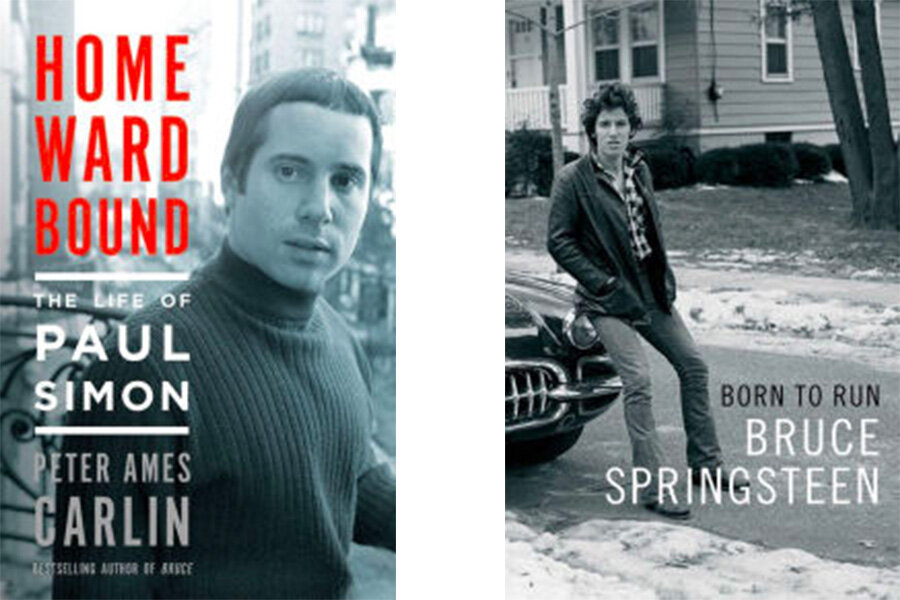'Homeward Bound' and 'Born to Run' trace the making of two American icons
Loading...
Paul Simon and Bruce Springsteen. Two of America’s greatest songwriters, singers, and troubadours. We sing along with their hits, we’ve absorbed and lived their lyrics as if they were our very own. They belong to us. They are us. But what do we really know about these two public, yet very private, people?
Two revealing new biographies say, “not much.” In Homeward Bound: The Life of Paul Simon, (unauthorized) biographer Peter Ames Carlin waxes rhapsodic about the sheer beauty, variety, and inventiveness of Simon’s musical output; yet he also paints an unflattering portrait of the artist as both a young and an older man, attributing his burning ambition as much to a need to better his competitive, disapproving father and show up partner Art Garfunkel as anything else.
In Born to Run, Springsteen’s riveting autobiography, Springsteen describes witnessing when he was about 7 years old the spectacle of young Elvis Presley on “The Ed Sullivan Show.” Suddenly the scuffling kid glimpses a ticket out of the gray-and-black world he’s growing up in, grimy Freehold, N.J. Springsteen is as much a product of his environment as any artist in memory, and his memoir is a compelling journey into the world that shaped him.
Simon grew up not too many miles from Springsteen’s childhood home and was also formed in the crucible of the New York metro area. It was at middle school in Queens that he first met Garfunkel. Envious of young Art’s angelic voice, height, and good looks, Simon was strongly drawn to this boy who shared his passion for doo-wop, rock ’n’ roll, and singing harmony. That their vocal blend was glorious was apparent from Day 1. But so was the contentiousness of their on-again, off-again relationship – a friction that sadly continues to this day, according to Carlin.
Though Simon has shared little that’s personal with the world at large, the shadow side of the writer of “Bridge Over Troubled Water,” “Homeward Bound,” and “Kodachrome” is a point of focus for the book’s author. Far and away the more ambitious of the duo, Simon secretly negotiated a solo deal behind Garfunkel’s back while signing their first record deal (60 years ago!). The book describes this as the first of many betrayals in the pair’s troubled relationship. Carlin’s account of Simon’s stinginess in sharing songwriting credits with other contributors throughout his solo career and apparent theft – from a trusting fellow musician – of the concept of what became his Grammy-winning “Graceland” album will leave a sour taste with fans.
But like any good biographer, Carlin finds the genesis of many of Simon’s finest songs in his tough personality and personal conflicts. “The Sound of Silence” reveals his go-it-alone status, and the first line, “Hello darkness, my old friend/ I’ve come to talk to you again,” speaks volumes about the man’s struggles.
Springsteen’s descriptions of his Catholic, Italian/Irish upbringing in a dead-end south New Jersey town are positively Dickensian. His Dutch/Irish father could never find suitable work and was surly and distant, sitting in the darkened kitchen by himself each night brooding and drinking, his son recalls.
Nothing young Bruce did pleased him, or garnered the faintest praise.
But Bruce’s mother, who is from the Italian side of the family, had an unrequited lust for life, for dancing, music, and self-expression. She had vowed to love and honor her husband and would never leave him, so her son became her Walter Mitty. She encouraged his musical ambitions, helping him buy his first guitar. Fueled by driving ambition, he practiced until his fingers bled. Bar band by bar band, first as guitarist but eventually graduating to frontman, the “Bruuuuuuce!!!” we’ve come to know and cheer was born.
But over the decades, the “black melancholy” his father endured has often visited his superstar son, too. Springsteen chronicles the toll it has taken on his friendships, marriages, the inner workings of his E Street Band, and on the man himself. Springsteen only recently admitted his lifelong struggles with depression, in conjunction with this book’s release. That Springsteen seems so vital, so in control on the stage, and has brought so much joy to millions, makes this confession especially poignant.
No single biography or autobiography can define an entire life. As a songwriter myself, I had hoped these two books would offer more insight into the creative processes of these two musical giants, lessons from their famous struggles with writer’s block, and tips on continuing to find fresh inspiration over long careers.
OK, maybe next time. But what these two books do reveal is what makes these men tick, what continues to drive them, and what conspires to hold them back. Simon and Springsteen are genuine American treasures. In both cases, so much of their remarkable work was shaped by the people and places of their childhoods.
John Kehe is the Monitor’s design consultant.








